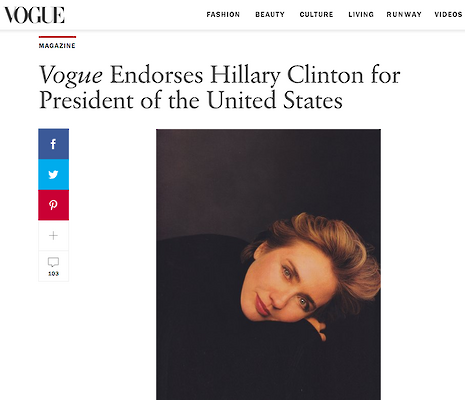Vogue did politics, and it didn’t work
Agustin Ferrari-Braun explores why Vogue‘s endorsement of Clinton was counter-productive

A Chanel dress, a Savile Row suit, a Parisian Runaway, and a Vogue cover... Founded in 1892, the American magazine is a synonym of fashion, even for people who are not particularly interested in it. Throughout more than a century, it has been at the forefront of clothing and lifestyle both in America and Europe and published pieces by the most important fashion journalists in the world. But one thing it hadn’t done before the American election was endorse a political candidate.
In an editorial published on 18th October, the fashion magazine declared that it would support Hillary Clinton’s campaign because “her fierce intelligence and considerable experience are reflected in policies and positions that are clear, sound, and hopeful”. This could hardly be seen as unexpected. The internationally famous Vogue editor, Anna Wintour, was extremely vocal about her positive views on Clinton and helped her campaign by hosting many fundraisers, including an entire fashion show that took place in Manhattan in September.
However, the kind of support that the magazine has provided for Clinton is exactly the one she didn’t need; they tried to help but ended up harming. The first problem was obvious: writing about fashion is not quite the same thing as writing about politics. A style that comes across as funny, approachable and straightforward when talking about Helsinki’s best restaurants quickly becomes insulting, insensitive and disrespectful when giving tips about how to become a political refugee in Canada.
The second problem was the over the top and constant praise of Clinton in fields where she didn’t want nor need to be praised. As Elizabeth Huang explained in a previous article, the Secretary of State consciously chose to wear very discrete outfits that would vary very little and thus help her avoid traditional fashion questions that sexist media tend to ask powerful women. Hence seeing her coming second in a list of “The Best Headbands of All Time” between Brigitte Bardot and Audrey Hepburn was just laughable. Not only did it fail to foster admiration, but it actively conveyed the message that she would be praised by the media no mater what she did.
And the reaction of the readers was exactly the one we could expect. The incompetent treatment of themes that were far from the area of expertise of the writers and their mindless adulation left their audience fed up. For instance, out of 66 comments on an article called “5 Things You Didn't Know About Hillary Clinton”, only four were positive. Most of them said things like “I don't need to know anything else about her" and "I’ve had enough of her lies”.
Vogue was wholeheartedly devoted to Clinton. Yet, as happened far too often in this election, they failed to produce a coherent discourse that would rally people around its candidate. The American magazine was nothing more than one of the many media that managed to alienate its audience and strengthen Trump’s claim that the information conglomerates were against him. Fashion and politics are not irreconcilable; in fact, we need fashion journalism that addresses politics and political journalism that addresses fashion. But it has to be done with good judgement and consciousness of the consequences of the published pieces. Hopefully this is what Vogue and the industry in general will learn during the next four years
 Interviews / You don’t need to peak at Cambridge, says Robin Harding31 December 2025
Interviews / You don’t need to peak at Cambridge, says Robin Harding31 December 2025 News / Downing investigates ‘mysterious’ underground burial vault 29 December 2025
News / Downing investigates ‘mysterious’ underground burial vault 29 December 2025 News / Unions protest handling of redundancies at Epidemiology Unit30 December 2025
News / Unions protest handling of redundancies at Epidemiology Unit30 December 2025 Lifestyle / Ask Auntie Alice29 December 2025
Lifestyle / Ask Auntie Alice29 December 2025 Features / ‘Treated like we’re incompetent’: ents officers on college micromanagement30 December 2025
Features / ‘Treated like we’re incompetent’: ents officers on college micromanagement30 December 2025








